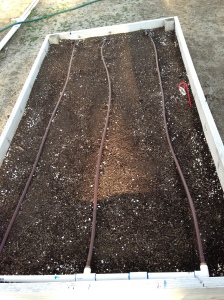 Brown line in a grow box[/caption]
Brown line in a grow box[/caption]Having an automatic watering system set up for your garden can save you many hours over the course of the year. I love watering my garden by hand, but it takes dedication and consistency. It also makes it very hard to go over night anywhere during the summer. It is well worth the few hours of work it takes to install the system. I would highly recommend doing a drip system vs a sprinkler system. Sprinklers do not conserve water as much of it evaporates, but also the leaves of the plants get wet opening them up for
[caption id="attachment_1603" align="alignright" width="210"]
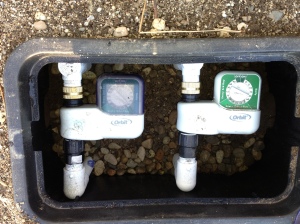 Battery powered timers in a box that is run with lines run underground.[/caption]
Battery powered timers in a box that is run with lines run underground.[/caption]disease. Your drip system can be run entirely over ground, partially under ground or all the way under ground until you get to the grow box of course.
For example, if you do not have the infrastructure set up for the system to be under ground with the timers and pressure reducers already in place, you can do it from the hose sprocket! Simply connect the reducer, and the battery powered timer at the hose then run the hose over to the grow box, then run the drip lines around the grow box. That is the fastest way to install a system. The problem is the hose and pieces exposed to the sun and elements will deteriorate faster than if they are protected out of the elements.
[caption id="attachment_1605" align="alignleft" width="210"]
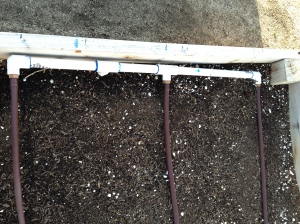 Close up on how to connect brow line at the head of the box.[/caption]
Close up on how to connect brow line at the head of the box.[/caption][caption id="attachment_241" align="alignright" width="210"]
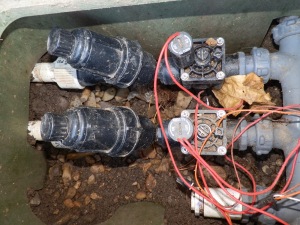 Reducers and timers in a system planned out and set up before the yard and garden was installed.[/caption]
Reducers and timers in a system planned out and set up before the yard and garden was installed.[/caption]Or you could dig some trenches around the boxes, and up into the boxes and connect into your water line. Then you can install in line timers for each box that are battery powered. The draw back to battery powered is they will need battery changes and you would need to watch for the batteries to need to be changed. But the nice thing about this is you can set each timer differently for each box so that if one box needs more water than another, you can customize it for each box.
The best method is to plan ahead, trench and run all the lines for each box ahead of time, then install the garden after. This will last the longest but will also take the longest initially to install.
[caption id="attachment_272" align="alignright" width="210"]
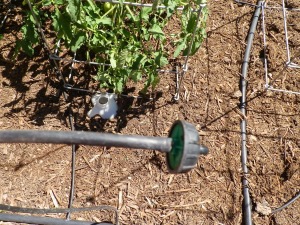 This is a one gallon dripper that we used to use for our tomato plants. We changed over to the brown line for everything as it is less work than to adjust this to accommodate our garden changes every year.[/caption]
This is a one gallon dripper that we used to use for our tomato plants. We changed over to the brown line for everything as it is less work than to adjust this to accommodate our garden changes every year.[/caption]We used to customize our drip system every year depending on what we had planted there. For the tomatoes and squash plants we would install 1 or 2 gallon drippers and some would have the brown line with drippers every 6 to 12 inches. But after doing this a few years realized that it was not cost or time effective and the beds with the brown drip line seemed to work for even the tomato plants. So now we just do the brown drip line in all of the boxes. Then we don't have to worry about changing it each spring depending on what we have planted.
Related articles
- Why a Drip Irrigation System? (diy-home-tips.com)
No comments:
Post a Comment